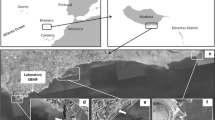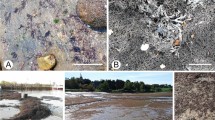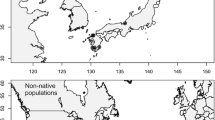Abstract
Variabilities in the responses of several South African red and green macroalgae to direct grazing and the responses of one green alga to cues from grazers were tested. We used two feeding experiments: (1) testing the induced responses of three red and one green algae to direct grazing by mesograzers and (2) a multi-treatment experiment, in which the direct and indirect effects of one macrograzer species on the green alga Codium platylobium were assessed. Consumption rates were assessed in feeding assays with intact algal pieces and with agar pellets containing non-polar extracts of the test algae. Defensive responses were induced for intact pieces of Galaxaura diessingiana, but were not induced in pellets, suggesting either morphological defence or chemical defence using polar compounds other than polyphenols. In contrast, exposure to grazing stimulated consumption of Gracilaria capensis and Hypnea spicifera by another grazing species. In the multi-treatment experiment, waterborne cues from both grazing and non-grazing snails induced defensive algal traits in C. platylobium. We suggest that inducible defences among macroalgae are not restricted to brown algae, but that both the responses of algae to grazers and of grazers to the defences of macroalgae are intrinsically variable and complex.



Similar content being viewed by others
References
Adler FR, Karban R (1994) Defended fortresses or moving targets? Another model of inducible defenses inspired by military metaphors. Am Nat 144:813–832
Baldwin IT, Schultz JC (1983) Rapid changes in tree leaf chemistry induced by damage: evidence for communication between plants. Science 221:277–279
Bruin J, Sabelis MW, Dicke M (1995) Do plants tap SOS signals from their infested neighbours? Tree 4:167–170
Carpenter RC (1986) Partitioning herbivory and its effects on coral reef algal communities. Ecol Monogr 56:345–363
Ceh J, Molis M, Dzeha TM, Wahl M (2005) Induction and reduction of antihervibore defenses in brown and red macroalgae off the Kenyan Coast. J Phycol 41:726–731
Cetrulo G, Hay ME (2000) Activated chemical defenses in tropical versus temperate seaweeds. Mar Ecol Prog Ser 207:243–253
Cronin G (2001) Resource allocation in seaweeds and marine invertebrates: chemical defense patterns in relation to defense theories. In: McClintock JB, Baker BJ (eds) Marine chemical ecology. CRC Press, Boca Raton, pp 325–353
Cronin G, Hay ME (1996) Induction of seaweed chemical defenses by amphipod grazing. Ecology 77:2287–2301
Deal MS, Hay ME, Wilson D, Fenical W (2003) Galactolipids rather than phlorotannins as herbivore deterrents in the brown seaweed Fucus vesiculosus. Oecologia 136:107–114
Del Val A, Platas G, Basilio A, Cabello A, Gorrochategui J, Suay I, Vicente F, Portillo E, Jiménez del Río M, García Reina G, Peláez F (2001) Screening of antimicrobial activities in red, green and brown macroalgae from Gran Canaria (Canaria Isalnd, Spain). Int Microbiol 4:35–40
Duffy JE, Hay ME (1991) Food and shelter as determinants of food choice by an herbivorous marine amphipod. Ecology 72:1286–1298
Duffy JE, Hay ME (1994) Herbivore resistance to seaweed chemical defense: the roles of mobility and predation risk. Ecology 75:1304–1319
Foster G, Hodgson AN (1998) Consumption and apparent dry matter digestibility of six intertidal macroalgae by Turbo sarmaticus (Mollusca: Vetigastropoda: Turbinidae). Aquacul 167:211–227
Hammerstrom K, Dethier MN, Duggins DO (1998) Rapid phlorotannin induction and relaxation in five Washington kelps. Mar Ecol Prog Ser 165:293–305
Hay ME (1992) The role of seaweed chemical defenses in the evolution of feeding specialization and in the mediation of complex interactions. In: Paul VJ (ed) Ecological roles of marine natural products. Comstock Publishing Associates, Ithaca, pp 93–118
Hay ME (1996) Marine chemical ecology: what’s known and what’s next? J Exp Mar Biol Ecol 200:103–134
Hay ME (1997) The ecology and evolution of seaweed–herbivore interactions on coral reefs. Coral Reefs 16:S67–S76
Hay ME, Fenical W (1988) Marine plants-herbivore interactions: the ecology of chemical defences. Annu Rev Ecol Syst 19:111–145
Hay ME, Renaud PE, Fenical W (1988) Large mobile versus small sedentary herbivores and their resistance to seaweed chemical defenses. Oecologia 75:246–252
Hay ME, Duffy JE, Paul VJ, Renaud PE, Fenical W (1990) Specialist herbivores reduce their susceptibility to predation by feeding on the chemically defended seaweed Avrainvillea longicaulis. Limnol Oceanogr 35:1734–1743
Hay ME, Kappel QE, Fenical W (1994) Synergism in plant defenses against herbivores: interactions of chemistry, calcification, and plant quality. Ecology 75:1714–1726
Jones JI, Young JO, Haynes GM, Moss B, Eaton JW, Hardwick KJ (1999) Do submerged aquatic plants influence their periphyton to enhance the growth and reproduction of invertebrate mutualist? Oecologia 120:463–474
Karban R, Agrawal AA, Mangel M (1997) The benefits of induced defenses against herbivores. Ecology 78:1351–1355
Kazlauskas R, Mulder J, Murphy PT, Wells RJ (1980) New metabolites from brown alga Caulocystis cephalornithos. Aust J Chem 33:2097–2101
Kazlauskas R, King L, Murphy PT, Warren RG, Wells RJ (1981) Metabolites from brown algal genus Cystophora. Aust J Chem 34:439–447
Kerffoot WC, Newman RM, Hanscom Z (1998) Snail reaction to watercress leaf tissues: reinterpretation of a mutualistic ‘alarm’ hypothesis. Freshwater Biol 40:201–213
Lewis SM, Norris JN, Searles RB (1987) The regulation of morphological plasticity in tropical reef algae by herbivory. Ecology 68:636–641
Lindsay JR (1998) Effects of zone and wave exposure on population structure and recruitment of the mussel (Perna perna) in South Africa. Master of Science thesis, Rhodes University
Littler MM, Littler DS (1980) The evolution of thallus form and survival strategies in benthic marine macroalgae: field and laboratory tests of a functional form model. Am Nat 116:25–44
Lubchenco J, Gaines SD (1981) A unified approach to marine plant–herbivore interactions. I. Populations and communities. Ann Rev Ecol Syst 12:405–437
Macaya EC, Rothäusler E, Thiel M, Molis M, Wahl M (2005) Induction of defenses and within-alga variation of palatability in two brown algae from northern-central coast of Chile: effects of mesograzers and UV radiation. J Exp Mar Biol Ecol 325:214–227
McQuaid CD, Froneman PW (1993) Mutualism between the territorial intertidal limpet Patella longicosta and the crustose alga Ralfsia verrucosa. Oecologia 96:128–133
Nykänen H, Koricheva J (2004) Damage-induced changes in woody plants and their effects on herbivore performance: a meta-analysis. Oikos 104:247–268
Paul VJ, Van Alstyne KL (1992) Activation of chemical defenses in the tropical green algae Halimeda spp. J Exp Mar Biol Ecol 160:191–203
Paul VJ, Cruz-Rivera E, Thacker RW (2001) Chemical mediation of macroalgal–herbivore interactions: ecological and evolutionary perspectives. In: McClintock JB, Baker BJ (eds) Marine chemical ecology. CRC Press, Boca Raton, pp 227–265
Pavia H, Toth GB (2000) Inducible chemical resistance to herbivory in the brown seaweed Ascophyllum nodosum. Ecology 81:3212–3225
Pavia H, Cervin G, Lindgren A, Aberg P (1997) Effect of UV-B radiation and simulated herbivory on phlorotannins in the brown alga Ascophyllum nodosum. Mar Ecol Prog Ser 157:139–146
Peckol P, Krane JM, Yates JL (1996) Interactive effects of inducible defense and resource availability on phlorotannins in the North Atlantic alga Fucus vesiculosus. Mar Ecol Prog Ser 138:209–217
Rohde S, Molis M, Wahl M (2004) Regulation of anti-herbivore defence by Fucus vesiculosus in response to various cues. J Ecol 92:1011–1018
Sakata K, Tsuge M, Ina K (1986) A simple bioassay for feeding stimulants for the young sea hare Aplysia juliana. Mar Biol 91:509–511
Solandt JL, Campbell AC (2001) Macroalgal feeding characteristics of the sea urchin Diadema antillarum Philippi at Discovery Bay, Jamaica. Caribb J Sci 37:227–238
Sotka E, Taylor RB, Hay ME (2002) Tissue-specific induction of resistance to herbivores in a brown seaweed: the importance of direct grazing versus waterborne signals from grazed neighbours. J Exp Mar Biol Ecol 277:1–12
Stachowicz J (2001a) Chemical of mobile benthic invertebrates: predators and prey, allies and competitors. In: McClintock JB, Baker BJ (eds) Marine chemical ecology. CRC Press, Boca Raton, pp 157–194
Stachowicz J (2001b) Mutualism, facilitation, and the structure of ecological communities. BioScience 51:235–246
Steinberg PD (1994) Lack of short-term induction of phlorotannins in the Australasian brown algae Ecklonia radiata and Sargassum vetitum. Mar Ecol Prog Ser 112:129–133
Steinberg PD, Van Altena I (1992) Tolerance of marine invertebrate herbivores to brown algal phlorotannins in temperate Australasia. Ecol Monogr 62:189–222
Steinberg PD, De Nys R, Kjelleberg S (2001) Chemical mediation of macroalgal–herbivore interactions: ecological and evolutionary perspectives. In: McClintock JB, Baker BJ (eds) Marine chemical ecology. CRC Press, Boca Raton, pp 355–387
Steneck RS, Watling L (1982) Feeding capabilities and limitations of herbivorous molluscs: a functional group approach. Mar Biol 68:299–319
Taylor RB, Sotka E, Hay ME (2002) Tissue-specific induction of herbivores resistance: seaweed response to amphipod grazing. Oecologia 132:68–76
Toth GB, Pavia H (2000) Water-borne cues induce chemical defense in a marine alga (Ascophyllum nodosum). Proc Natl Acad Sci USA 97:14418–14420
Underwood AJ (1997) Experiments in ecology: the logical design and interpretation using analysis of variance. University Press, Cambridge
Underwood AJ, Jernakoff P (1984) The effects of tidal height, wave-exposure, seasonality and rock-pools on grazing and the distribution of intertidal macroalgae in New Wales. J Exp Mar Biol Ecol 75:71–96
Underwood GJC, Thomas JD, Baker JH (1992) An experimental investigation in snail–macrophyte–epiphyte systems. Oecologia 91:587–594
Van Alstyne KL (1988) Herbivore grazing increases polyphenolic defenses in the intertidal brown alga Fucus distichus. Ecology 69:655–663
Van Alstyne KL (1989) Adventitius branching as an herbivore-induced defense in the brown alga Fucus distichus. Mar Ecol Prog Ser 56:169–176
Van Alstyne KL (1995) Comparison of three methods for quantifying brown algal polyphenolic compounds. J Chem Ecol 21:45–58
Van Alstyne KL, Wolfe GV, Freidenburg TL, Neil A, Hicken C (2001) Activated defense system in marine macroalgae: evidence for an ecological role for DMSP cleavage. Mar Ecol Prog Ser 213:53–65
Waterman PG, Mole S (1994) Analysis of phenolic plant metabolites. Blackwell Scientific Publications, Oxford
Weidner K, Lages BG, da Gama BAP, Molis M, Wahl M, Pereira RC (2004) Effect of mesograzers and nutrient levels on induction of defenses in several Brazilian macroalgae. Mar Ecol Prog Ser 283:113–125
Williams KS, Myers JH (1984) Previous herbivore attack of red alder may improve food quality for fall webworm larvae. Oecologia 63:166–170
Yates JL, Peckol P (1993) Effects of nutrient availability and herbivory on polyphenolics in the seaweed Fucus vesiculosus. Ecology 74:1757–1766
Acknowledgements
Thanks are due to the Stiftung Mercator for provided funding for the project, to John Higgs for the loan of a sand filter during the experiment and to all correctors for suggestions on this manuscript. All the animals and algae used in this study were collected with the permission of the environmental affairs office of South Africa.
Author information
Authors and Affiliations
Corresponding author
Additional information
Communicated by J.P. Thorpe, Port Erin
Rights and permissions
About this article
Cite this article
Díaz, E., Güldenzoph, C., Molis, M. et al. Variability in grazer-mediated defensive responses of green and red macroalgae on the south coast of South Africa. Mar Biol 149, 1301–1311 (2006). https://doi.org/10.1007/s00227-006-0320-6
Received:
Accepted:
Published:
Issue Date:
DOI: https://doi.org/10.1007/s00227-006-0320-6




